

|
Home Updates Hydros Cars Engines Contacts Links Racing Contact On The Wire |
Swedish Reminiscences
|
|
My first ever visit to Sweden occurred in 2005 after an invite from Kjell-Erik Odelius who, after my book on the Oliver marque was published, asked me to present it to those who visit the Brommakannan at Orebro, the 'Old Timer' and modern tether car event which takes place in early May each year. He further suggested he would pick me up from the nearest airport to Orebro, which was Vasteras roughly 100km from the municipal tether car track, and share accommodation with me at the Sanna Kroa Motel nearby. He was true to his word and after a very cheap Ryanair flight we were soon on our way down to Orebro in Kjellís car, a Volvo of course. We called at a friend of Kjellís about half way, Martii Tavast who lived alone, but to me a kindred spirit who loved model engines, having a vast collection plus many other collectables including books, oil lamps, model planes, steam engines and several vintage motorcycles. He also had a fully equipped engineering workshop in the basement. Needless to say we got on well and still do to this day, both men becoming very good friends. His bungalow was literally stuffed with artefacts making it almost impossible for us to sit, or for him to lie down in his bed. This is how, or possibly why he lived alone I later surmised? |
|
The Sanna Kroa was a typical Swedish log cabin type of building and had two tiers of cabins one on top of the other, it was nice and warm with the usual facilities and a good restaurant plus, at that time, a petrol filling station and small shop. It was situated on E18 a main trunk road to be by-passed a few yearís later. It was then very busy. After a good self-service breakfast we headed for the track and I was introduced to all the Swedes and one Norwegian, there were two other Brits Stan Barrett and Ken Willshire neither of whom I had met previously. Right: 'Old timer' cars with Stan Barrett left and Mats BŲhlin right |
|
I had taken the ex Gerry Buck 'Bottoms Up' with disc valve induction, a very early Oliver Tiger twin shaft of which only seven were made. After recently making a replica of the lost original prototype Tiger I know why they soon changed to rotary valve, being much easier to productionise and replicate. My first run on the very hard original Raylite tyres caused the car to flip and in the next run to shed the body top half. My second run improved to 96kph from 86 kph on the first, not bad for this plain bearing engine on aged tyres. The Old Timer event winner event is determined by declaring the nominated speed and then achieving the nearest to it in the two, timed official runs. I only wanted to record a time, speed not being that important to me, as I had never run a tether car previously and this was my second only visit to a car track!! My first being the Derby Raynesway track when my father took me before I reached my teens in circa 1949.
 |
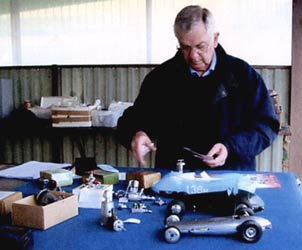 |
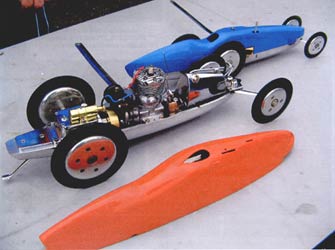 |
| Firing up the 55 year old Oliver | John with sale items | Janne Oberg's Dooling and Rossi cars |
The modern cars simply blew my mind, they are impossible to track by eye and it becomes a noise spectacle with eyes clamped to the timing display to see the speed gradually climbing once on the pipe, to their maximum and then after shutting off, several laps to come to a stop. I was told the 1.5cc car engines ran up to almost 45 000 revs and even the 10cc at close to 38,000 mind boggling. Today they run to even higher speeds I understand?? (this was also the first outing for Mats BŲhlin's new 10cc cars, one of which went on to win two European Championships)
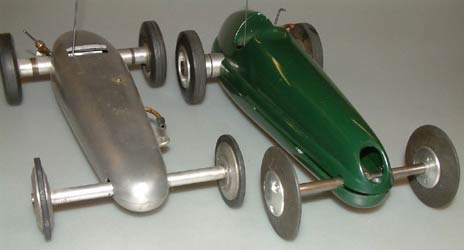 |
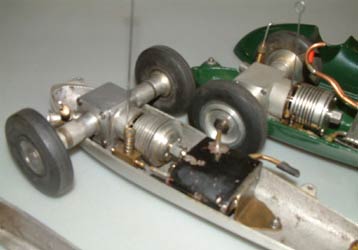 |
| Disc valve Bottom's Up. Tiger Two Five | DV and MkII RV motors |
I had taken a few engines to try and sell together with a few of my books as advised by KEO. The two books that did not sell, I gave as prizes on the final day, which ended with a meal provided by the host club and their ladies using the shared Club House as a venue. I had been made extremely welcome and they implored me to ask John S. Oliver to join me the next year and I agreed to approach him. Kjell took me back to Vasteras airport and an uneventful trip back home, refusing to accept any payment for my accommodation, or daily transport. A most enjoyable and enlightening experience, which was to be repeated in future years.
At the turn of the year John S. Oliver now aged 82 had agreed to the invitation and I booked four seats return with Ryanair from Stansted to Vasteras again and a suitable hire car a Volvo V50 to act as our transport. Stan Barrett and my son Paul joined us to share the costs. Lars-Olaf Johansson who had become a friend and customer kindly booked two rooms at the Sanna Kroa Motel for us and so all was arranged. We met at 04.30 in the morning at the booking in desk at Stansted and a problem soon arose?? A keen customs lady detected a smell she did not like in my luggage which turned out to be the paint on a Teardrop car I just built with a Jena twin cylinder engine, this was eventually let through. However Johnís recently run Oliver cars were refused travel and had to be left in a safe deposit locker. John was very upset, but had been dropped off by his relation at the entrance, otherwise he said he would have gone back home, so not a good start.
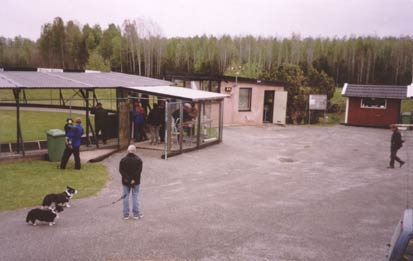 |
 |
|
Orebro Track |
|
We travelled down safely and booked into the Sanna Kroa motel and went for an evening meal sharing a bottle of red stuff between us, John visibly relaxed, in fact even more so after breakfast and getting to the track and being lauded as Special Guest of Honour. I had taken an Oliver Tiger 'Two Five' car with a late Oliver twin shaft, one of the last ten JSO ever completed after his association with Ivan Prior ended. It had never been run before by me and John helped me get it set up and running reasonably well. The fastest speed recorded was 107.607 kph (67.25 mph) not a great speed, but as a novice I was happy to get the run.
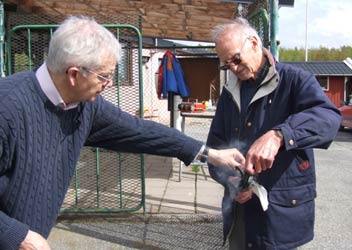 |
 |
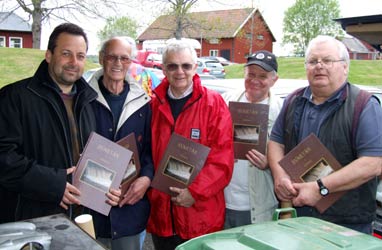 |
| John's tweaking the Tiger | Apres race | Paul, John O, John G, Stan, Stuart |
Among the usual side stalls Ulf Ek had a set of Slabang castings with tyres and front suspension set up which I purchased and hoped to have it running the next time I went over. I took photos of Ulfís car to help in the build of my own version, it would have a basically standard Oliver twin shaft engine. On the Saturday night after evening meals were taken we were invited to Rickard Helanderís room for a friendly drink. We took what we could obtain from the site shop, bags of peanuts and crisps and a bottle of red from the restaurant. A most enjoyable occasion even though we could not understand all of the conversation, John Oliver was quite talkative and even a little giggly before we retired and a lot more relaxed than when we left England. Prize giving on the final day ended with most of the English attendees receiving an award of some kind making it a most memorable occasion indeed. John was staggered at the speeds and sophistication of the modern cars.
John had managed to get over his previous disappointment and decided to join me again in 2007, this time taking his IP Pumpkin powered with an Oliver Battleaxe twin shaft engine. I took the Slabang for it first run after running the engine on a 7" x 6" propeller to get a close setting. It is very difficult to get final settings good enough for the best speeds from my very limited track time with such a hectic Friday practise day filled with Old Timer and a lot more modern cars all requiring a different tether line, making the next chance to run a lottery of opportunity. Ulf Ek provided me with suitable diesel fuel the first year and I had brought him a bottle of Scots Malt Whisky in appreciation and in all subsequent years too. I had again taken the Slabang to run and after one good run in practise decided the needle needed a leaner setting, result was seizure just after it was getting near maximum speed, disaster. John kindly offered to rebore it for me after we got home, which he duly did. However I had manage to approach 150KPH and I thought a slightly leaner setting might help and optimistically declared 160KPH target speed. John had again helped me with settings and sound advice and enjoyed his own runs. That curtailed my activities to spectating and to helping others and strangely I have very little more recollection of the rest of the weekend. Looking back possibly the most pleasurable time was the evening meal taken with the Swedish enthusiasts and ourselves, all mixing well and enjoying the banter helped by sharing a kbottle of red each, as usual.
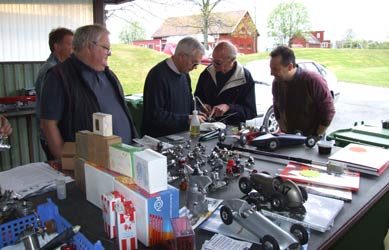 |
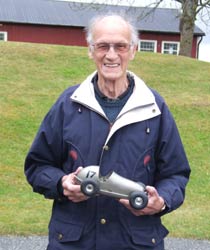 |
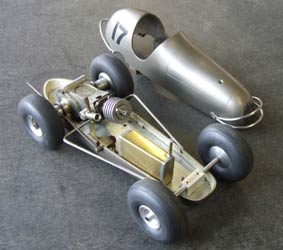 |
| Stuart, John G, John O, Paul G | John Oliver | Battleaxe powered Pumpkin |
Towards the end of the year I was approached by Tom Ridley who had attempted to persuade John S. Oliver to sell him the rights to the Oliver name and engine designs with no response from JSO. So I went over to his works at Clint Hill Engineering and met Tom and was shown his works and introduced to Works Manager Steve Fardon and Tomís wife Julie who acted as Company Secretary. It came out in conversation Tom Had ridden Speedway for Coventry Bees at the time I used to go to Brandon Speedway near Coventry to watch the racing and recall Tom, so we got on well. I wrote a report on the facilities and Tomís keenness to buy the Oliver brand name and sent this off to JSO and the outcome was that they then got together and John sold the rights and what tooling he wanted, but most importantly offered to show Tom how to hone and lap the cylinder assemblies to obtain the legendary Oliver Fits. In most of the early Clint Hill production JSO finished and assembled the cylinders I understand. So in late 2007 Tom Ridley started official Oliver Engine production again commencing engine numbering from where the last JSO built engines were made.
John and I had again agreed we would visit Orebro in May 2008 for the Old timer event and we decided it would be good if Tom joined us and he agreed. We thought it would give him a grounding of where Oliver engines emanated from and in addition be an interesting trip for him? I picked Tom up from his home near Coventry in my trusty Skoda Octavia estate and we headed off down to Stansted and met John there. I had taken my Slabang again and JSO a 'Bottom's Up' and promptly proved that he had lost none of his touch in fifty years with two almost identical runs at 107kph. The Slabang had a slow first run, but after tweaking settings recorded 141 in the second, but against a target speed of 135? What was momentous however was that it would be the last time John S. Oliver would join me in visiting what had effectively become my home track. I know John thoroughly enjoyed his visits to Orebro where his father in 1949 had introduced their prototype engine to the world, which was to become possibly the most famous of British model engines ever, the "Oliver Tiger".
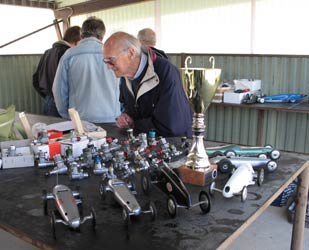 |
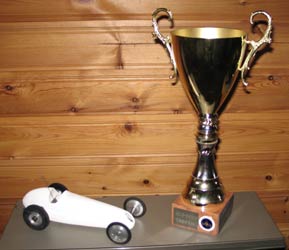 |
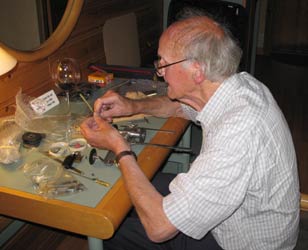 |
| British cars and engines on display | Oliver Tiger 'Two Five' with trophy | John Oliver working on 'Bottom's Up' |
Just myself making the trip in 2009, still with the target of 161kph, the magic 100mph. Ulf Ek had shown that the Slabang/twinshaft combination was more than capable, having achieved over 170kph previously. Could I finally break the 100mph barrier for the first time by a British competitor with a retro style car and engine? The timed runs on the Saturday went exceedingly well for me with the first being 161.749kph and the second 162.506kph just over 101mph in each case, but not close enough to my declared speed of 160 to figure in the results. This was the first time I had managed over 100 mph officially with a basically standard Oliver twin Shaft engine, and faster than the existing British MCA record, so I was very pleased. The Swedes build special narrow track engines, which save about a square inch in cross sectional area over standard and gain a lot more track time and hence experience and some 16kph faster than my standard car. Today I put the speed I achieved down to the superbly smooth, high grip track surface and a good slice of beginners luck, together with sound advice and help.
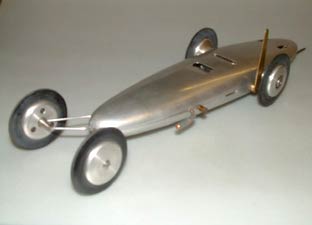 |
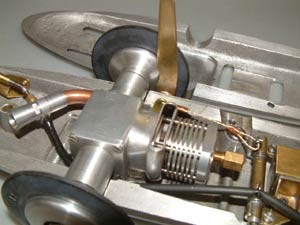 |
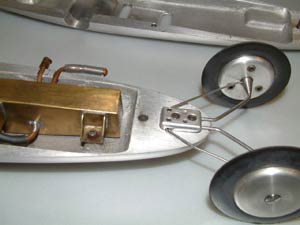 |
| 100mph Slabang | The 'works' | Front suspension |
John
Goodall
Orebro Vartavling
2025
My last visit to Sweden and Orebro was in 2023 when I was picked up from Gothenburgís Landvetter airport where Ryanair fly to by Martii Tavast a good friend of both Kjell-Erik Odelius and myself who I first met back in 2005. Ian Harper had agreed to join me this time and offered to do the driving and a lot of the logistical organisation too, arranging flights and car hire. I arranged accommodation with long time friend Kjell-Erik where we would stay for the first two nights and the last in his garden cottage as he calls it. Kjell Lives in Fjallbacka, an old fishing village close to the harbour and it is up near the border with Norway and much closer to Oslo, than Stockholm. Kjell also booked the Sanna Kroa Motel room for us where I have stayed many times previously and it is still good and very cheap at £35 night each for B&B, just 1 mile from the Orebro Tether Car Circuit, so very convenient too.
We left Barton under
Needwood early on Wednesday the 14th May with Ian staying the night
here to facilitate the 5.30am leaving time as we had to call on his daughter in
Bedford to leave Ruby, his aging pet dog, before driving on to Stansted for the
Ryanair flight. We arrived at Landvetter and went to pick up the hire car a
Volvo P40 estate booked from Hertz. We were surprised when Ian was told the P40
was not available, but they would give a free upgrade to a V70 hybrid electric
Estate with all mod cons and near new, very lucky as it turned out? A complete
contrast to the car hire experience we had together last February in Germany.
|
The drive up to Fjallbacka was without any mistakes or incident with Ianís route programming skills of the satnav making things very straightforward skirting around Gothenburg city. Why donít all hire cars have satnav as standard? They wanted to charge extra in Germany for its use on the downgrade VW Golf?? We got an emotional reception from KEO with hugs for us both and shown the cottage accommodation with wine and beer provided in the fully contained facility with shower, cooking facilities, fridge etc., plus two bunk beds in a separate room. We retired early being very tired. The next day was spent looking through Kjell's collection of tether cars, model boats, model planes and engine collection, which filled the upstairs floor entirely. Ian spent some time loading Kjellís zimmer frame, large bag and sticks ready for the next day and were thankful for the upgrade as the V40 would have been too small. Right: Kjell-Erik and Martii |
|
We had an early start
for Orebro on the Friday, the first day of practice, as we both needed this. Kjell had given us some diesel fuel selected from several glass bottles with glass
stoppers and rubber washers in his loft. We arrived at Orebro about mid day as
there were a lot of road works causing diversions and slow single lanes round
them. We prepared both Slabangís my 100mph non standard, but with standard
engine and the ex John S. Oliver car run once by him in 2015 which I lent to Ian
to run. I introduced Ian to all those I could remember in the rather depleted
attendance from my last visit. Starting the engine was not as easy as normal,
but I did not think too much about that, I should have? I got my engine running
and had to reset compression and needle still no concern. The first run was
poor and after three more it got very little better and Ian could not even get a
start, damaging the front suspension twice in attempts. Then Ulf Ek offered us
some of his fuel, a vast improvement, but no time left to fine tune and reset
the engines again as it was time to pack up and check into the Sanna Kroa room
6. After a quick shower we went to eat in the restaurant. I had meat balls and
Ian Steakburger at a cost of 134 kroner about £11 with all the trimmings plus a
bottle of red stuff between us.
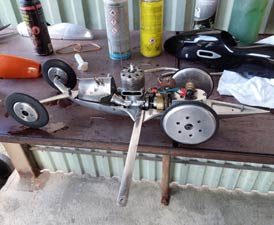 |
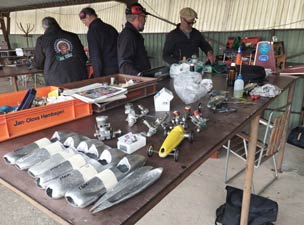 |
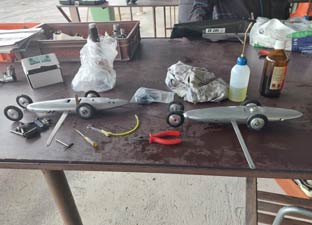 |
| Last of the side exhaust cars | John and Ian's sale table | Two Slabangs and 'iffy fuel' left |
After dinner we had to
take Kjell up to Kolback near to Vasteras approx. 100km away, one of the
Stockholm satellite airfields, where he was staying with Martii Tavast and another experience for Ian. We were both guided around Martiiís
garden of which he is very proud. He built an underground cold room in one
corner which works very well for storing household items. After cake and a drink
of Martii's home made whisky we went to explore his collection. He lives on
his own and so things are slightly disorganised shall we say? His basement
covering the whole house outline is filled with model engines, a lot home made, a
collection of torches, oil cans, Geiger counters and nuclear items from visits
to Russia. There are motorcycle parts, headlamps off cars, magnetos and all
manner of things. His vast machine shop is crammed with two mills, a large
centre lathe, a Myford ML7, a capstan lathe and all the usual drills, hand
tools including a four spindle drilling machine, grinders etc. Martii used to
make a living through manufacturing many household items for supplying local
supermarkets with useful goods.
 |
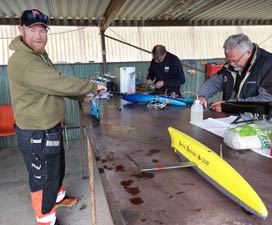 |
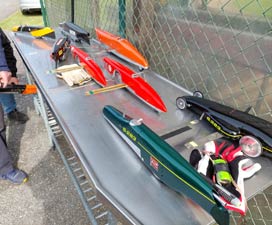 |
| Mats Johanssen | Boris Astrom | FEMA cars ready to run |
His house is heated
from a 70 meter deep bore hole pumping water down and back heated, heating to a
nice toasty level. He has backup wood burners and solar panels, being very
efficiency and ecology minded. The living area is surrounded with books, toys
and many artefacts from WW2 shells to a tether car. We reluctantly left just
before 11.00 pm and got to bed at midnight. Whacked again.
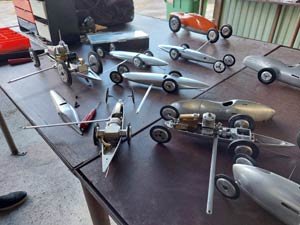 |
 |
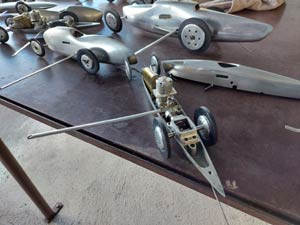 |
| Wonderful selection of 'old timer' tethered cars | ||
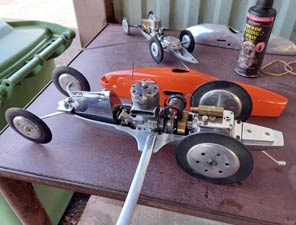 |
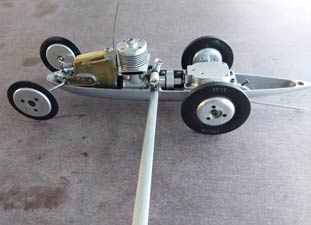 |
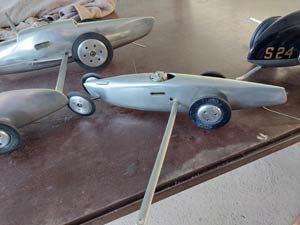 |
After a good breakfast
of bacon and hard boiled egg with lovely bread we left for the track at about
9.00am. Martii and Kjell joined us for breakfast and evening meals. The Old
Timer event is a regularity run where you have to declare your average speed
over eight laps and the nearest to it wins, so a good chance for those who know
their cars well with regular fuel. With settings way off we stood no chance at
all, I did manage three runs after trying a few tweaks to no avail and Ian again
could not get a start at all. Jan Erik Falk, multiple World and European Champion, came to give
Ian some help, backing off the compression where things started to improve for him,
eventually getting a good clean run, still slower than expected, but good enough
to come fourth overall, I was fifth. We each got a diploma recording our runs
plus a couple of SMRU stickers, the diplomaís nicely hand scrolled in script by
Rickard Helander a nice gesture and a good memento for Ianís first visit and
probably my last. Back to the Sanna Kroa, a shower, meal and bed exhausted once
more.
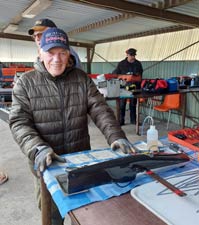 |
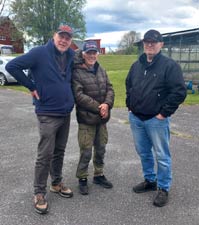 |
 |
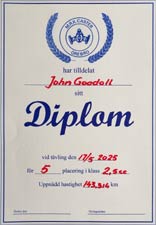 |
| Jan-Erik Falk | Ian, Jan Erik & Kenth Jansson | Rickard Hellander | The Diploma |
 |
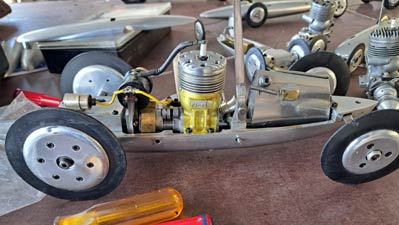 |
 |
| Ake Ekestrand | Lovely 10cc car with Yellow Jacket motor | Boris on horsing duties |
Old friend Ake Ekstrand visited both Saturday and Sunday on his electric buggy being transported from his nursing home, he was pleased to chat with us both, a lovely man sadly no longer involved with his past passion and a founder of the Orebro track. He wished to be remembered to all of his old friends in England. For Kjel-Erik he also declared it would be his last visit and he made his own farewells emotionally.
|
We waited to see Torbjorn Johanesson from Norway run his two cars as he had made over 280KMH in practice with a 2.5cc car, both exquisitely and completely made him. (Torbjorn, 2023 European Champion, World and European record holder in Class 2 was making an attempt on his existing record)
We left to travel back to Fjallbacka calling at Mariestad
for drinks, but most cafes were shut this being Sunday, so we ended up in a
Macdonalds for refreshment. Mariestad is a fishing port on the shores of Lake
Vanern the largest inland lake In Sweden. It is the home of Boris Astrom a
dynamic horser and Tether car enthusiast, as was his late father Leif.
Boris makes a living fishing on lake Vanern. The lake is that large that if you
are in the middle you cannot see land in any direction.
|
|
We had a meal with Kjell and Lena and went to bed early, for an early rise and run back to Landvetter for the flight back to Stansted. Arriving about mid day on the 19th May, with no problems either way at customs. We got home to Barton under Needwood near to tea time after a diversion on the A14 up the A6 to Bedford and picking up Ruby, mission accomplished.
My sincere thanks and appreciation go to Ian for his friendship, his organisation, his patience with elderly gentlemen and excellent driving skills. John Goodall.
©copyrightOTW/JohnGoodall2025